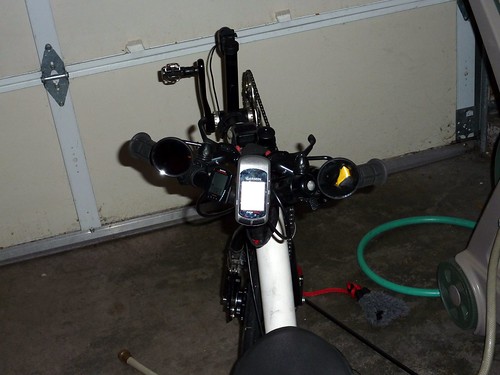
Recently I have been considering streamliners as commuting platforms. The so-called "practical streamliner" bike problem. This is an interesting problem to be solved.
Commercially there are a few approaches that have been taken.
- The Velomobile, a tadpole trike platform with a shell. Examples include the Quest, the Go-One, the Sorcerer, etc. Most are heavy (~70lbs) and the tadpole format adds a certain about of tire scrub and rolling resistance. Even so, this is the format that is the most common for practical applications today. It is also very fast as long as you don't have too many hills.
- Fabric and wireframe Faired bikes, the Lightning F-40, which holds the fasted time ever in RAAM is the classic example. Faired Easy Racer Gold Rushes are another common example and the lowracer above with a customer carbon fiber front fairing and cover is within reach. These tend to be lighter, in the 30-40lbs range and the cost is lower. The speeds are good, especially since the weight is low and low weight means that climbing is not as affected.
- Hardshell streamliners, tub bikes, these are the real speed bikes, also about ~70lbs with limited steering radius and other practical limitations. These tend to be individually produced with custom design features. There are examples that have been made more practical and can be used in general traffic and riding applications. Joe's streamliner built around a varna clone shell is one example
The question is what makes a good platform to build a streamliner around. You want a number of components.
- Suspension, a streamliner is faster and due to the opaque body generally has reduced forward visibility for road bumps and hazards. You will hit bumps fast and you want to be able to handle it. Suspension also helps stick to turns better at speed. Most streamliners can easily average in the mid 20s MPH or low 30s MPH if the road is reasonably flat or rolling hills. Suspension helps make this comfortable and keeps the tires on the road.
- Large Gear Range, a streamliner wants high gears to avoid spinning out in the 25-30mph range. It also wants low gears to climb hills with the extra weight. A gear range from 17 GI to 120GI is adequate for most practical applications. This can be accomplished with a jackdrive (intermediate drive), an internal hub, or something like the SRAM dual drive.
- Indirect Steering, indirect steering or some other method to control how much your steering apparatus goes to the side during turns. Traditional Tiller and U bar steering can take up quite a bit of width during turns, widening your profile and reducing the aero benefits of the streamlining. Indirect steering can eliminate this entirely though it does add complexity. Other solutions are sitting very close the the fork and putting a small T bar steering directly on top of it.
- Entry, Exit and Stoplight solutions, a trike of some sort makes a good practical streamliner since entry, exit and stopping/starting are all pretty simple as long as you can get in and out of the fairing. Bike solutions have to worry about bomb-bay doors for the feet, clearance for derailleurs , etc. The inherent stability of trikes helps a lot for low speed handling like climbing. Most of the practical 2 wheel streamliners have either open bottoms or do something with bomb bay doors (complex) or fabric (simple) to improve the aerodynamics on the underside. Entry and exit is also very tricky with a 2-wheel streamliner. The F-40 and other fabric/nosecone solutions solve this reasonable well. Many 2 wheel hardshell solutions require helpers to launch/catch them. This is not very practical.
- Storage, some form of storage and luggage capacity. A streamliner is useful for both speed and weather protection. You will want to carry the odd bit of groceries, a change of clothes or maybe a laptop. 20 -to 40L of storage is a nice thing to have. The extended tail section of most streamliners does provide a location that suits many designs. Even a way to add a small basket back there provides useful storage.
Looking at this list, you can see why tadpole trikes do well as velomobiles. I am looking for a bit more speed and less tire scrub so I am considering a tilting trike as a platform. Though a lowracer modification such as the one pictured above is also highly tempting. I suspect I could invest $1000 or so into such a solution and come up with something workable.
-Duncan




